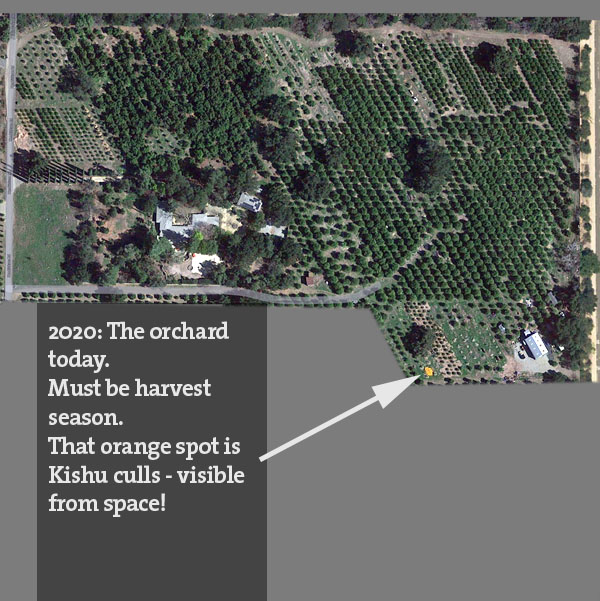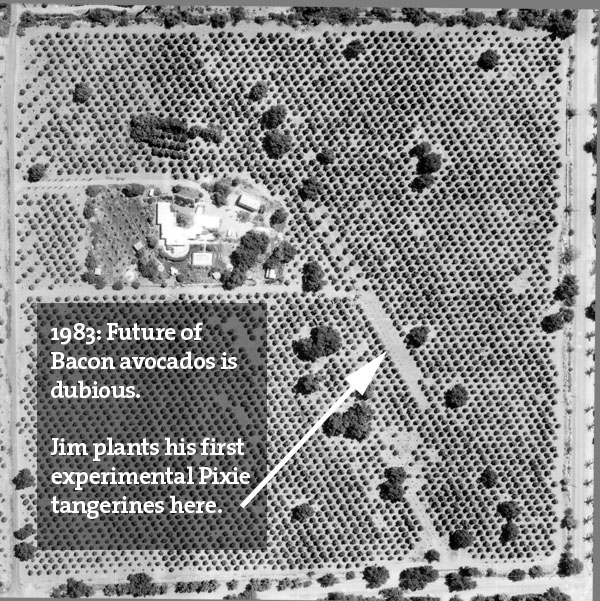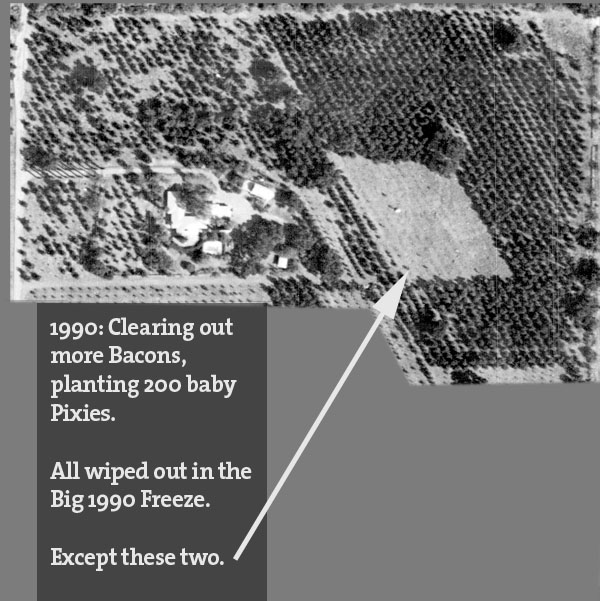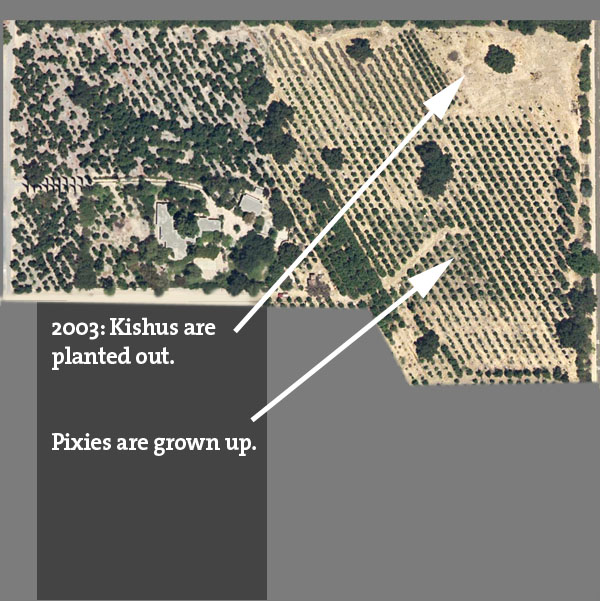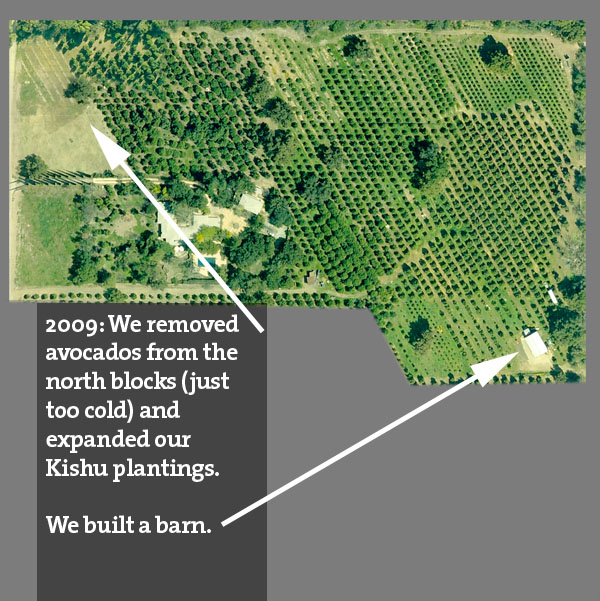Churchill Orchard changes constantly. The oaks remain, but the working trees rotate through. Here’s a history of its evolution.
This is a 1965 aerial photograph of the 40-acre parcel that Jim’s dad purchased in 1970. The McCaskey’s had built a nice modern house, planted a domestic orchard of valencias, navels, grapefruit, dancy tangerines, a lime tree, a MacArthur avocado, a Mexicola Grande avocado, and several fuerte avocados. They also had an enormous pasture; the rest of the land was essentially virgin vegetation consisting of oaks and chaparral, bisected by trails. The well for the property was in the upper right (southeast) corner.
To finance the planting of the new orchard, Jim’s dad (a.k.a. “Church”) carved out the house as a separate lot and sold it. He saved the old backyard orchard of citrus and Fuerte avocados; and planted Bacon avocados on the remaining 37 acres. The land remains dotted with oak trees because the orchard was Church’s retirement plan – his idea was that the family would sell off 5-acre parcels as they needed money; he left the oaks as future home sites.

Jim arrived at Churchill Orchard in spring 1978. This was the first aerial photo he had taken. The Bacons in this picture are about 4 years old and headed for their first harvest.
By 1979 the orchard began to lose trees to phytophera cinnamomi, a water-borne soil-dwelling organism that kills the roots of avocado trees, known around here as avocado root rot. Root rot was sweeping the Valley.
Jim spent a spring and summer cutting down dead trees, tarping the soil with plastic and pumping methyl bromide – a toxic fumigant, also a potent greenhouse gas – under the plastic to sterilize the soil. An idiotic proposition, that you could make a 10’x10′ square of soil safe for avocado roots in 37 acres inhabited by an organism that spreads through water transport in the soil!
Meanwhile, the whole California avocado industry decided to focus on Hass avocados, leaving all the other avocado varieties – and their growers – in the lurch, with no marketing support.

In this 1983 picture, most of the orchard is still planted in Bacon avocados, and you can see plenty of blank spaces where trees have died. However, there’s a diagonal swath just south of the house, and in this space have been planted 66 Pixies, 24 Satsuma mandarins and 2 pummelos.
Faced with dramatic decline in prices and an orchard full of slowly dying Bacon trees, Jim figured he needed a different crop. For some reason, still mysterious to him, he decided he didn’t want to be a valencia orange grower and sell his fruit to Sunkist – he wanted to grow something he could sell himself.
Jim had an encounter with a Pixie Tangerine at Friend’s Ranches packinghouse, and decided that’s what he would grow. Church decided to support Jim in this quixotic endeavor. Churchill Films had a long history of supporting quixotic filmmakers, so maybe it’s not surprising…
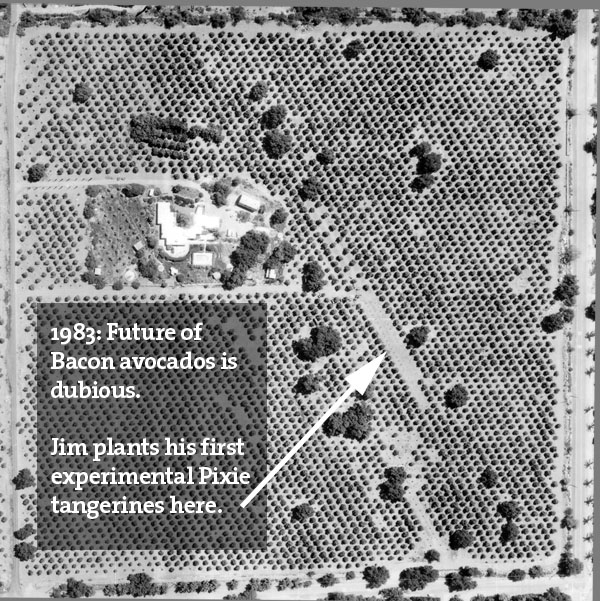
In this picture from 1986, the baby tangerines and other citrus are starting to grow up.
East and north of the house, in the warmest part of the orchard, most of the Bacon avocados have been grafted over to Hass avocados. The northwest corner shows lots of root rot damage.
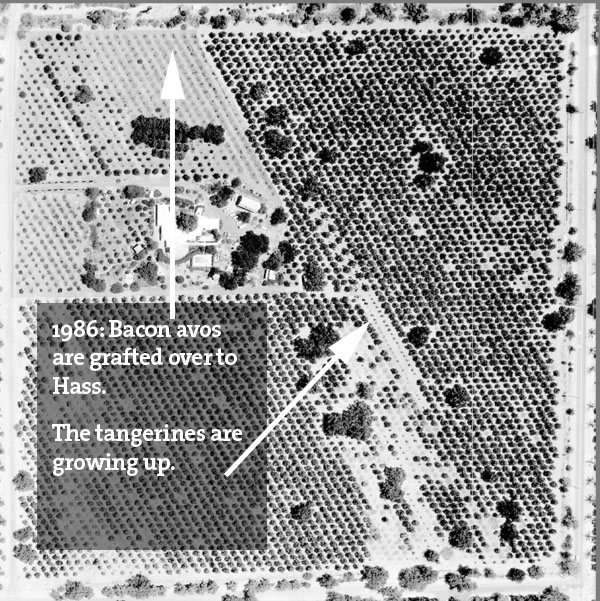
1989: Two lots totaling about 18 acres (bottom) have been sold off.
We have found our first wholesale customer, the Monterey Market in Berkeley, California, and are feeling good about being able to sell more tangerines. A good thing, because Ventura County has banned further parcel divisions forever, so Churchill Orchard will remain 17 acres.
The Pixie planting is expanding, with 5 new rows planted, and we have started clearing land to plant still more Pixie trees. East of the house the Hass grafts are now 4 years old and starting to look pretty good.
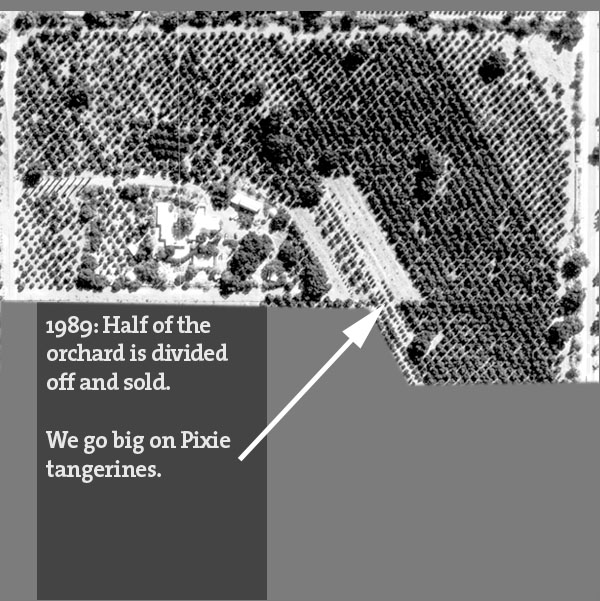
1990: We have taken out more bacon avocados south of the house. We will plant 200 baby pixie tangerine trees this spring, but we are about to encounter the freeze of 1990, an arctic polar express which is the worst freeze since 1937. Temperatures at McNell Road, on the west, reached as low as 18º; all the hass and 198 of the 200 baby pixies will be wiped out.
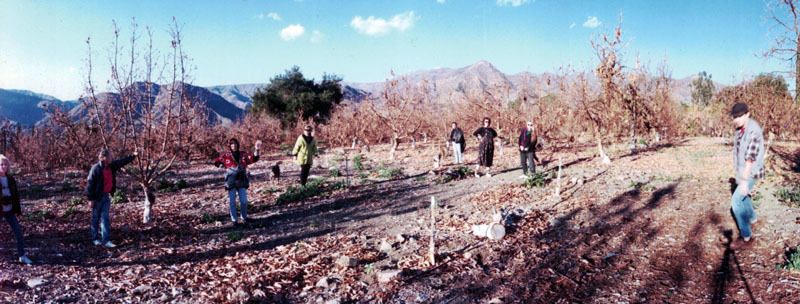
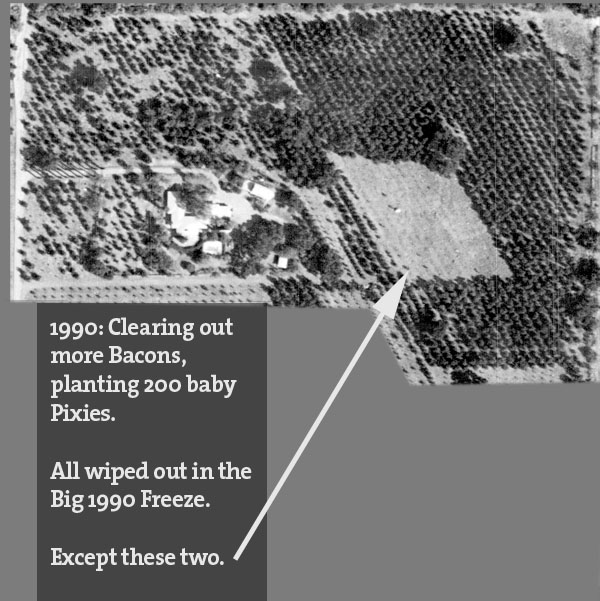
It’s 1993. East of the house the avocado block is beginning to recover from the 1990 freeze – some of the trees are growing back as hass, some of the trees are growing back as bacons, some of the trees don’t come back – it depends on how badly any given tree was damaged. South of the house we have cleared more bacon avocados to get ready to plant more pixies.
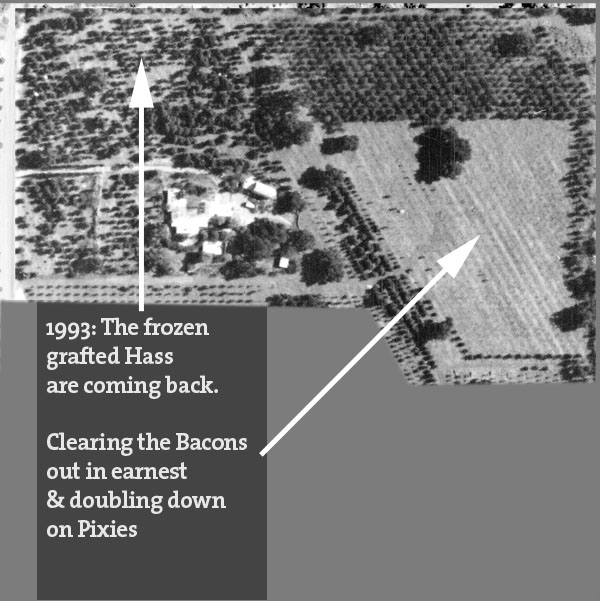
By 1996 we have cleared the remnants of the original bacon avocado planting. The avocado block east of the house is fully recovered, as a lovely mess of mixed varieties. The 200 trees planted south of the house in 1992 are big enough to show up on the photo, and the rest of the previously cleared area has also been planted to pixies. Paul Davis and Jim came out and cut down the rest of the original bacon planting to the east, to make way for… who knows what?
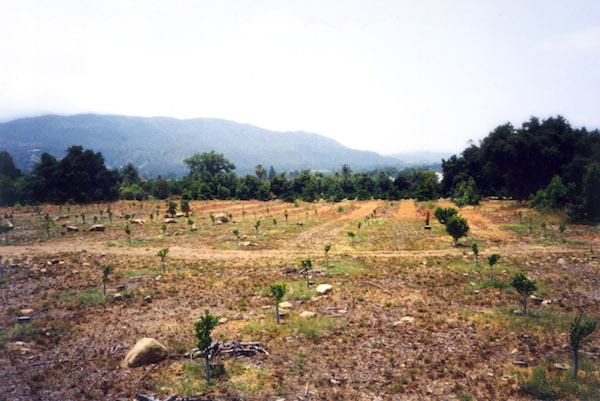
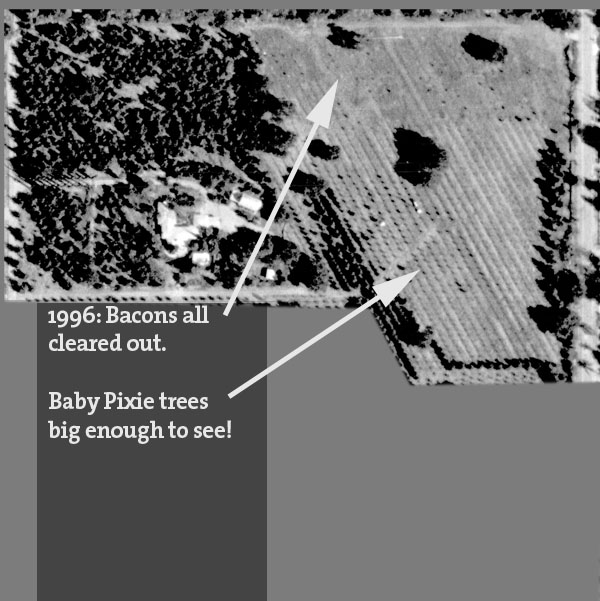
2003: Our first Seedless Kishus. The Citrus Variety Collection contains two trees of every kind of citrus known, from all over the world – horticultural varieties, rootstocks, fruit grown for aromas, plain old wild citrus.
On a visit to the collection in 1998, we asked Ottilia Bier, Collection Curator, about her favorite tangerine. Ottilia’s response was, “Well, the graduate students like the Seedless Kishu.”
We figured – these are graduate students in citrus, they spend a lot of time here in the Variety Collection, and out of all the edible varieties they like the Seedless Kishu. Let’s plant some.
In the south-east corner there’s some vacant land with an oak tree in the middle; to the north you can see three rows of tightly planted Seedless Kishus – the beginning of our adventure with that variety. By 2003 the Seedless Kishu trees have grown big enough to show on the aerial photo. North of those three rows we have planted more Pixies, plus some heterogenous miscellaneous varieties extending to the avocado block, which by this time is showing continued losses to avocado root rot.
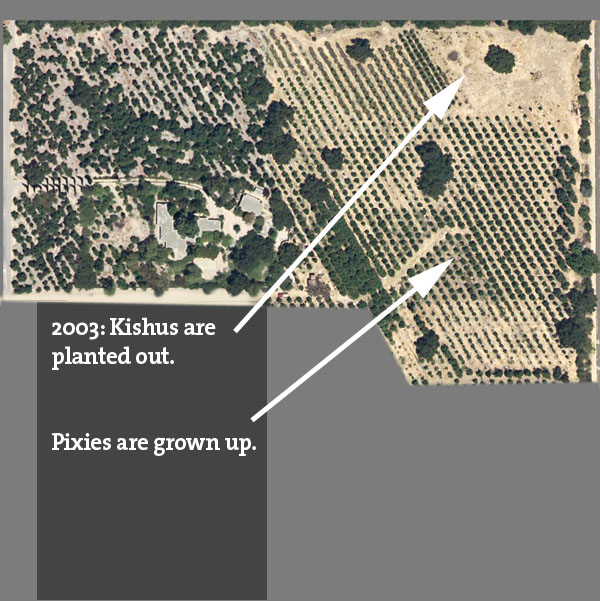
2009: Taking out more avocados. After a horrendous New Years Eve north wind event followed by a substantial freeze that dropped all the avocados in 2006, we took out the northern-most avocados.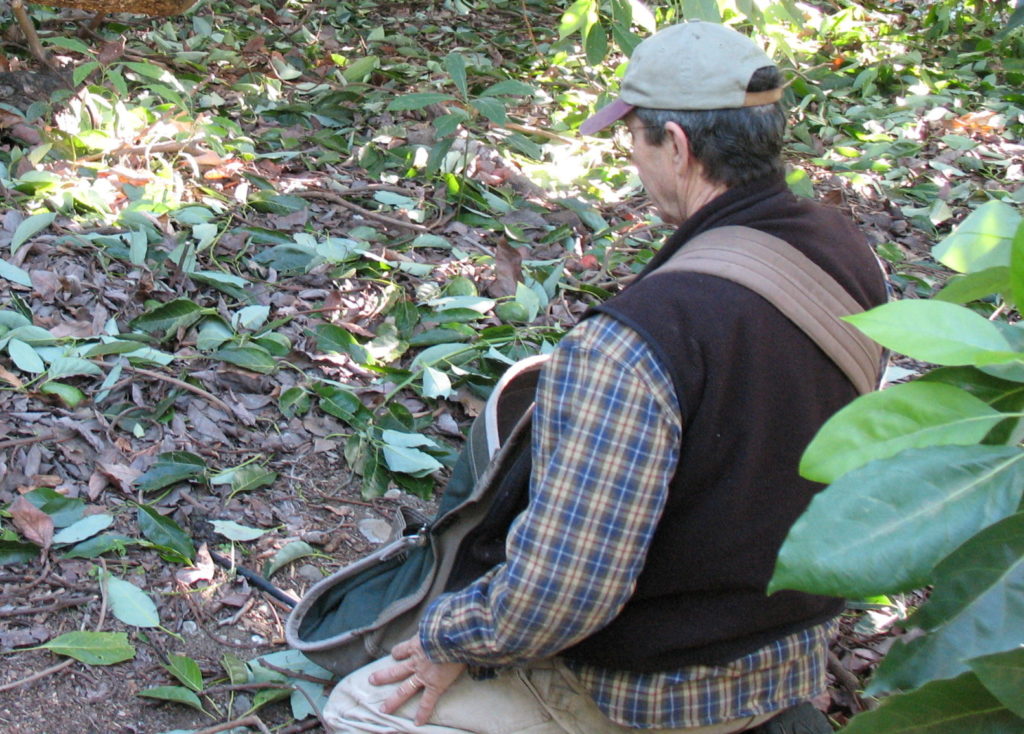
We have planted 50 Pages in the north-east corner, and in 2010 we will plant another 170+ Kishus. In 2005 we built a working barn – visible in the south-west corner. In 2007 we got all sanitary and added a washroom.
The south-east corner has been planted to another 310 Kishu trees, along with some Oro Blancos, Meyer lemons, and a couple of Buddha Hand citrus trees.
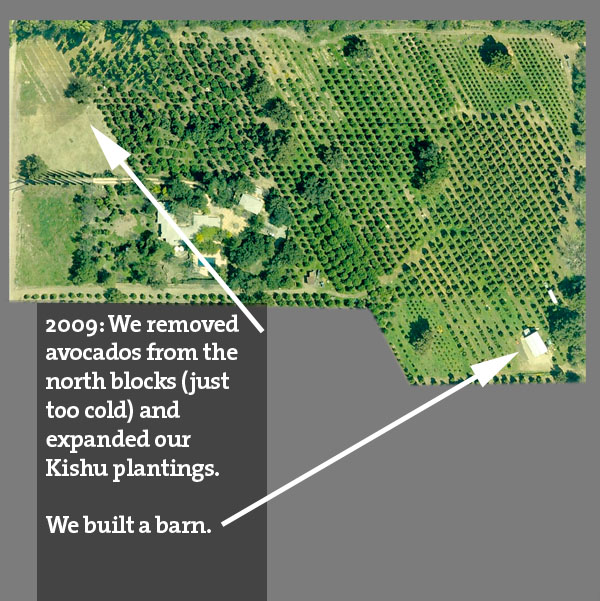
2016: All grown up. The Kishus we planted in the north-east block in 2010 are fully productive.
The original Pixie trees, planted in the early 1980’s, never got pruned and were a horrendous, 22′ tall mess. After a couple years of trying to bring them down in height and rationalize their branch structure, we stumped them to let them regrow.
Just north of the barn we planted Pixies on a rootstock that didn’t work, so we have removed all the trees. Just below that vacant area are 25 Pixie trees planted in cooperation with Ventura County Cooperative Extension to test different new rootstocks for productivity and hardiness.
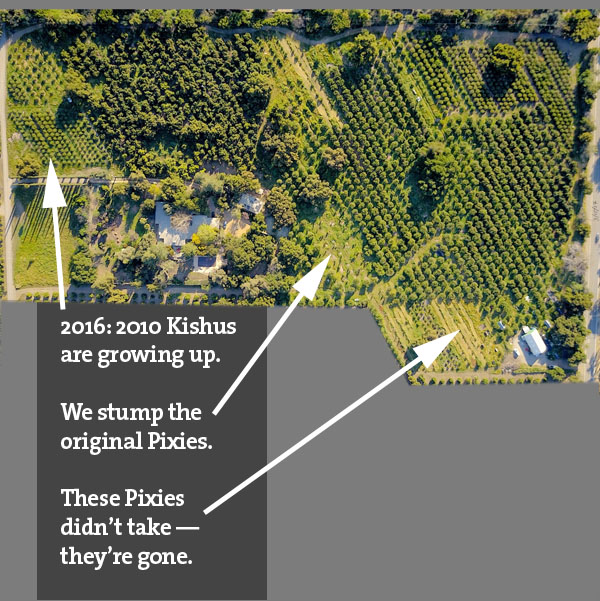
Churchill Orchard today. We haven’t stopped changing it up. Stay tuned.
We’ve continued to refine our collection.
Mike has steadily built beautiful native and insectary plant borders throughout the orchard.
With a mature orchard and limits on our irrigation water supply, we’ve focused a lot on improving our water efficiency. Newer more efficient irrigation lines, ardent mulching, and lots of pruning. We still keep a small zoo of rare and impractical citrus and avocados.
